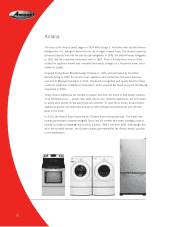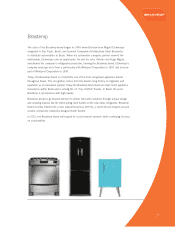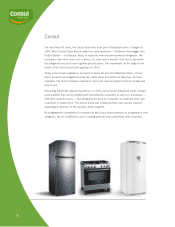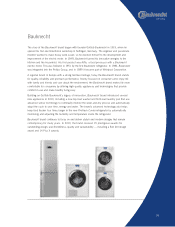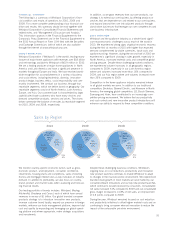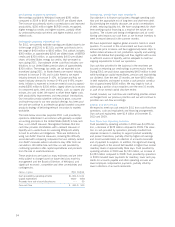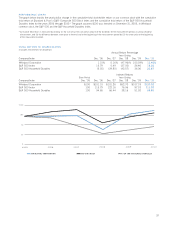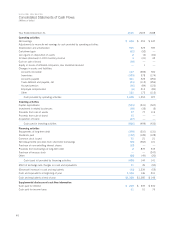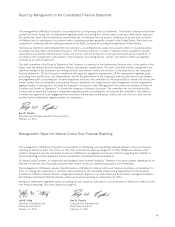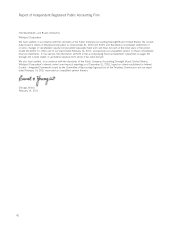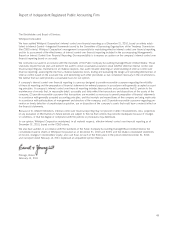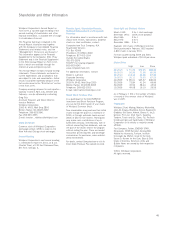Whirlpool 2010 Annual Report Download - page 41
Download and view the complete annual report
Please find page 41 of the 2010 Whirlpool annual report below. You can navigate through the pages in the report by either clicking on the pages listed below, or by using the keyword search tool below to find specific information within the annual report.36
MA RK ET RISK
We have in place an enterprise risk management process that
involves systematic risk identification and mitigation covering
the categories of enterprise, strategic, financial, operation and
compliance and reporting risk. The enterprise risk management
process receives Board of Directors and management oversight,
drives risk mitigation decision-making and is fully integrated into
our internal audit planning and execution cycle.
We are exposed to market risk from changes in foreign currency
exchange rates, domestic and foreign interest rates, and com-
modity prices, which can affect our operating results and overall
financial condition. We manage exposure to these risks through
our operating and financing activities and, when deemed appro-
priate, through the use of derivative financial instruments.
Derivative financial instruments are viewed as risk management
tools and are not used for speculation or for trading purposes.
Derivative financial instruments are generally contracted with a
diversified group of investment grade counterparties to reduce
exposure to nonperformance on such instruments.
We use foreign currency forward contracts, currency options
and currency swaps to hedge the price risk associated with
firmly committed and forecasted cross-border payments and
receipts related to ongoing business and operational financing
activities. Foreign currency contracts are sensitive to changes in
foreign currency exchange rates. At December 31, 2010, a 10%
favorable or unfavorable exchange rate movement in each cur-
rency in our portfolio of foreign currency contracts would have
resulted in an incremental unrealized gain or loss of approxi-
mately $175 million, respectively. Consistent with the use of
these contracts to neutralize the effect of exchange rate fluctua-
tions, such unrealized losses or gains would be offset by corre-
sponding gains or losses, respectively, in the re-measurement
of the underlying exposures.
We enter into commodity swap contracts to hedge the price risk
associated with firmly committed and forecasted commodities
purchases, the prices of which are not fixed directly through
supply contracts. As of December 31, 2010, a 10% favorable
or unfavorable shift in commodity prices would have resulted
in an incremental gain or loss of approximately $50 million,
respectively, related to these contracts.
In January 2009, Standard & Poor’s and Fitch Ratings lowered
our senior unsecured debt rating from “BBB” to “BBB-” and our
short-term corporate credit and commercial paper ratings from
“A-2” to “A-3” and “F-2 to F-3”, respectively, based on weak-
ened operating performance and the pullback in discretionary
consumer spending. Also in January 2009, Moody’s Investor
Services lowered our senior unsecured rating from “Baa2” to
“Baa3” and our commercial paper ratings from “Prime-2” to
“Prime-3” based on weakening appliance industry demand.
These rating adjustments may result in higher interest costs if
we were to seek additional financing in the capital markets.
FO RWARD -LOO KIN G S TAT EME NT S
This document contains forward-looking statements about
Whirlpool Corporation and its consolidated subsidiaries
(“Whirlpool”) that speak only as of this date. Whirlpool disclaims
any obligation to update these statements. Forward-looking
statements in this document may include, but are not limited
to, statements regarding expected earnings per share, cash flow,
productivity and material and oil-related prices. Many risks, con-
tingencies and uncertainties could cause actual results to differ
materially from Whirlpool’s forward-looking statements. Among
these factors are: (1) intense competition in the home appliance
industry reflecting the impact of both new and established
global competitors, including Asian and European manufacturers;
(2) Whirlpool’s ability to continue its relationship with significant
trade customers and the ability of these trade customers to
maintain or increase market share; (3) changes in economic
conditions which affect demand for our products, including the
strength of the building industry and the level of interest rates;
(4) product liability and product recall costs; (5) litigation and
legal compliance risk and costs, especially costs which may be
materially different from the amount we expect to incur or have
accrued for; (6) the effects and costs of governmental investiga-
tions or related actions by third parties; (7) the ability of Whirlpool
to manage foreign currency fluctuations; (8) global, political and/
or economic uncertainty and disruptions, especially in Whirlpool’s
significant geographic regions, including uncertainty and disrup-
tions arising from natural disasters or terrorist attacks; (9) the
ability of Whirlpool to achieve its business plans, productivity
improvements, cost control, leveraging of its global operating
platform, and acceleration of the rate of innovation; (10) inven-
tory and other asset risk; (11) fluctuations in the cost of key
materials (including steel, oil, plastic, resins, copper and alumi-
num) and components and the ability of Whirlpool to offset
cost increases; (12) the ability of suppliers of critical parts,
components and manufacturing equipment to deliver sufficient
quantities to Whirlpool in a timely and cost-effective manner;
(13) health care cost trends, regulatory changes and variations
between results and estimates that could increase future fund-
ing obligations for pension and post retirement benefit plans;
(14) Whirlpool’s ability to obtain and protect intellectual property
rights; (15) information technology system failures and data
security breaches; (16) the impact of labor relations; (17) our
ability to attract, develop and retain executives and other quali-
fied employees; and (18) changes in the legal and regulatory
environment including environmental and health and safety
regulations. Additional information concerning these and other
factors can be found in Whirlpool Corporation’s filings with the
Securities and Exchange Commission, including the most recent
annual report on Form 10-K, quarterly reports on Form 10-Q
and current reports on Form 8-K.


